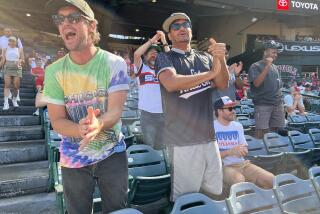Attendance Slump at Big A Does a Number on the Angels : Baseball: Turnstile count already off more than 90,000. Club officials caution that ‘it’s still early,’ and blame downturn on factors from economy to weather.
ANAHEIM — The season was young, and the Angels were three games over .500 and a half-game out of first in the American League West. But Anaheim Stadium seemed woefully empty on April 22.
A mere 19,857 fans paid to see the Angels’ game against Seattle, and they didn’t look like much in a stadium that seats more than 64,000 for baseball.
“Nineteen-thousand and change,” said Richard Brown, club president and chief executive officer, recalling the night last month when the Angels drew their smallest crowd since 1985. “That’s nothing to be proud of.”
The Angels, who return Monday to begin a six-game home stand, have drawn two crowds of fewer than 20,000 this season and nine of fewer than 25,000.
After 18 home dates, attendance already is down 90,671 from the same point last season. The average crowd has been 28,276, a decrease of 5,037 from last season.
“That hurts, and I’m not just talking about the bottom-line dollars,” Brown said. “You never want to feel like you’re not getting the fan support.”
There are reasons for the downturn, in particular for the small crowd of April 22, a Monday and one of those rare occasions when the Dodgers were home at the same time.
The Dodgers, who were playing only their second home game of the season, drew 42,723.
In addition, any examination of early returns has to be tempered with the same patience exemplified by one of the most time-honored phrases in baseball: It’s early.
Like a batting average, attendance tends to correct itself over time.
Attendance traditionally increases in direct correlation to the temperature, the number of youngsters out of school for the summer and the number of tourists in the area.
But the Angels acknowledge that they are concerned by the lag and concede that an increase in ticket prices, coinciding with a recession, probably has had an effect, particularly on season ticket sales.
The Angels typically raise ticket prices slightly every few years, and they raised them $1 or $2 on most tickets before this season. Season ticket prices rose correspondingly, meaning the least expensive season ticket for the 81-game schedule increased from $405 to $486, and the most expensive jumped $162, from $729 to $891.
“We had a price increase. That on top of the economy affected us,” said John Hays, senior vice president for marketing. “Baseball apparently has been affected by the downturn in the economy through the winter and currently, just as other sectors of the economy have. Plus, the Gulf War . . . affected season ticket sales.”
Hays believes the uncertainty created by Gulf tensions and then the outbreak of war slowed renewals of season tickets. Renewal notices go out in November, with a January deadline.
The Angels sold 17,229 season tickets--1,518 fewer than last season.
Still, even when the decrease in season ticket sales is taken into consideration, the walk-up attendance also has decreased, by an average of 3,519 fans a game.
That could be the result of any number of factors: scheduling, promotions, the opponent, the Angels’ performance--even the weather. Anaheim Stadium can turn chilly by the middle innings, and the average high temperature on days of home games this season has been almost six degrees cooler than last season.
“In marketing, there are at least 20 excuses for bad attendance, and there are probably that many factors,” Hays said.
“Who comes to town, that is a factor that varies season by season with who is popular or who is hot. Up until three or four years ago, the Oakland Athletics were a club we didn’t want to see come to town. Historically, the Yankees were one of the biggest draws by far. Today, it’s unlikely the average fan can name more than one or two players on the Yankees’ team.
“The White Sox, playing good or bad, draw well here as a reflection of the population out here. Boston continues to draw, plus they’re playing good. Clubs like Seattle, who have been death to attendance, have improved enough that the good baseball fans know, but the average fan still doesn’t know or doesn’t care.”
The Angels have played host to five of the same six teams this season as last, with the exception of trading popular Boston for Cleveland.
Last season, the Angels drew an average of 39,524 fans for each of three games against Boston in May.
This season, they drew an average of 20,895 for two games against Cleveland in April and May.
But the opposition is only one thing that can influence attendance. Some others:
* Day of the week, a factor magnified before school lets out for the summer.
Already this season, the Angels have played at home three of the first four Mondays. Both of their crowds of fewer than 20,000 were on Mondays. The other Monday was opening night, when the Angels drew a season-high 44,339.
Last season, the team played at home on Monday only twice in the first 18 dates, once on opening night and once in a May game against Baltimore that drew 23,126.
The Angels also have had only six Friday, Saturday or Sunday games in their first 18 games this season, compared to nine last season.
Other than opening night, the Angels have drawn as many as 40,000 only twice this season--both on Sunday.
Last season, the Angels had two crowds of more than 50,000 in the first 18 home dates--one on Saturday and one on Sunday.
* The Dodgers.
Although the teams usually do not play at home at the same time, the Dodgers played host to Atlanta April 22-24.
The Angels, who were facing Seattle, didn’t draw more than 24,638 in any of the three games coinciding with the Dodgers’ series against Atlanta.
* Promotional dates and giveaways.
The Angels, who say they will have fewer promotions in order to give away more valuable items this season, have had only three, compared to six in the first 18 home games last season.
* The team. This basic is easy to overlook in the confusion of scheduling and marketing details.
“I think the real key to attendance for any ballclub is the team’s performance. That’s always going to be No. 1,” Hays said. “We’ve played .500 baseball. That doesn’t lead to great enthusiasm, but on the other hand, we’re basically tied with everybody else for the lead in the American League West.”
Brown also notes that the team is “more competitive” than last year. This season, the Angels’ 18th home game was their 27th overall; they were 13-14 at that point (8-10 at home) and in fourth, 4 1/2 games out in the AL West. Last season, their 18th home game was their 32nd overall, and they were 12-20 (7-11 at home) and in sixth, 11 games out.
“Last year this time, we trailed by double-digits,” Brown said. “I’m hopeful the difference between this year and last year will be that we win it this year, but if we can’t win, at least we’ll be competitive to the last.”
The Angels have responded to the lower attendance by shifting some of their advertising emphasis, Brown said, but both he and Hays said the club sees no need for alarm yet.
“In summary, while we’re not satisfied by any means with where we are, we are not wringing our hands,” Hays said.
Brown dreams of the season the Angels will draw 3 million, topping their record of 2,807,260, set in 1982. He yearns to see the Angels follow the example of the Dodgers, who have reached 3 million eight times.
At their present rate, the Angels would draw 2,290,356 this season, although they certainly will draw more when attendance makes its traditional jump to summer levels.
Hays takes the long view. It’s a 162-game season, and that means 81 of them are at home.
“It’s May,” Hays said. “There’s (4 1/2) months of baseball ahead.”
An Increase...In Empty Seats Despite playing better baseball during the first 18 home games of the season, the Angels’ home attendance is lower substantially from a year ago. Club officials blame a number of factors: cooler temperatures, the tourist trade being off because of the economy, the Gulf War, head-to-head competition with the Dodgers and an increase in ticket prices. 1990 Attendance 1990 Average: 33,313 To Date Attendance is off 90,671, an average of 5,037. Particularly revealing is the decrease in Friday and Saturday night crowds: 5,126 fewer on Friday, 8,980 Saturday. 1990: 599,637 1991: 508,966 1991 Attendance 1991 Average: 28,726 50,000 Elusive Last year, two games--vs. the Yankees May 6 and vs. the Red Sox May 12--drew 50,717 and 50,755. This spring, the largest single-game attendance was 44,339 for the home opener April 15. Season Ticket Sales For the best seat in Anaheim Stadium, a season-ticket buyer saw an increase of $2 per ticket to $11 this spring. Total sales dropped from 18,747 last year to 17,229. 1990: $729 1991: $891 Source: California Angels
More to Read
Go beyond the scoreboard
Get the latest on L.A.'s teams in the daily Sports Report newsletter.
You may occasionally receive promotional content from the Los Angeles Times.






